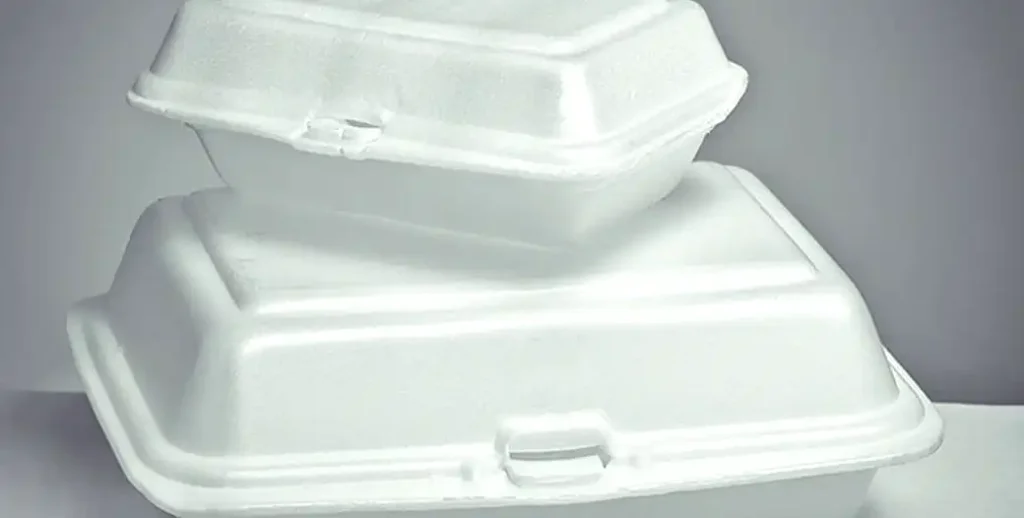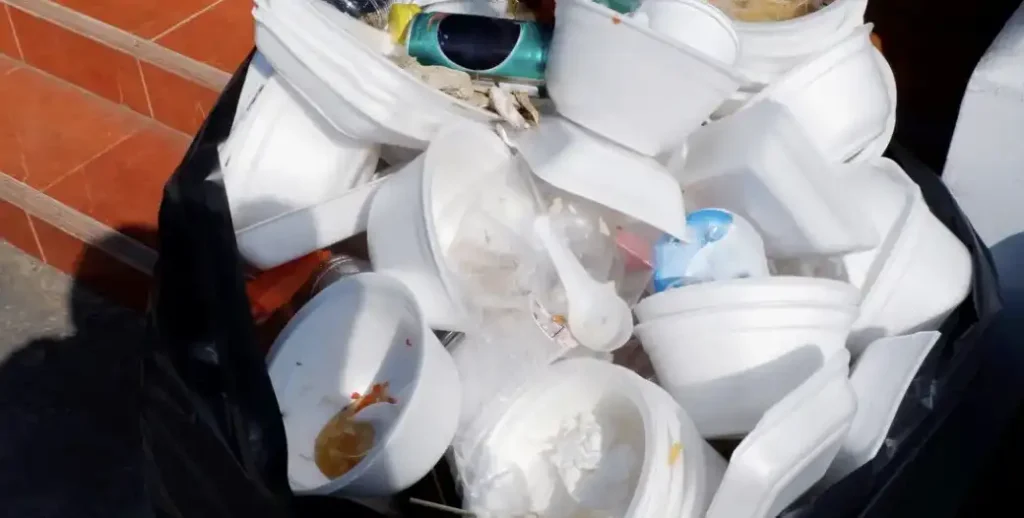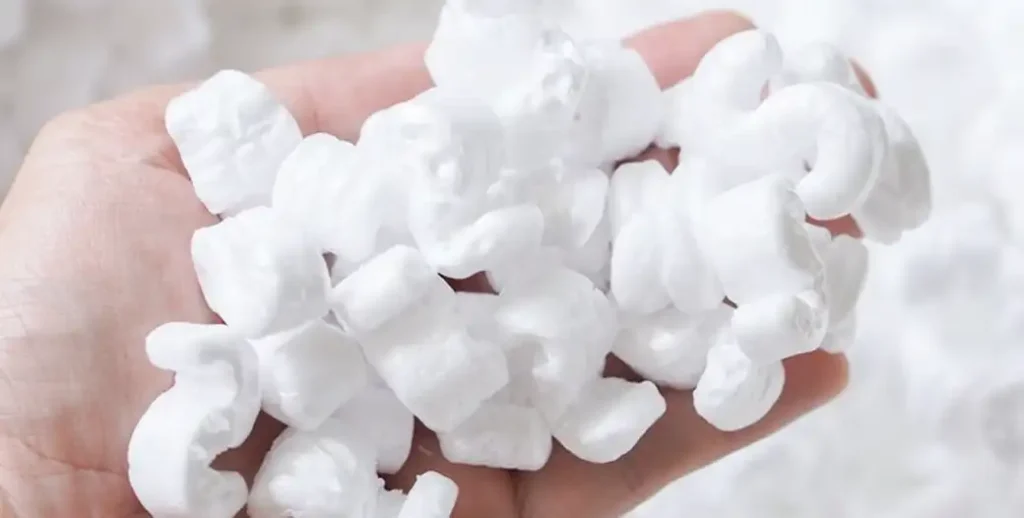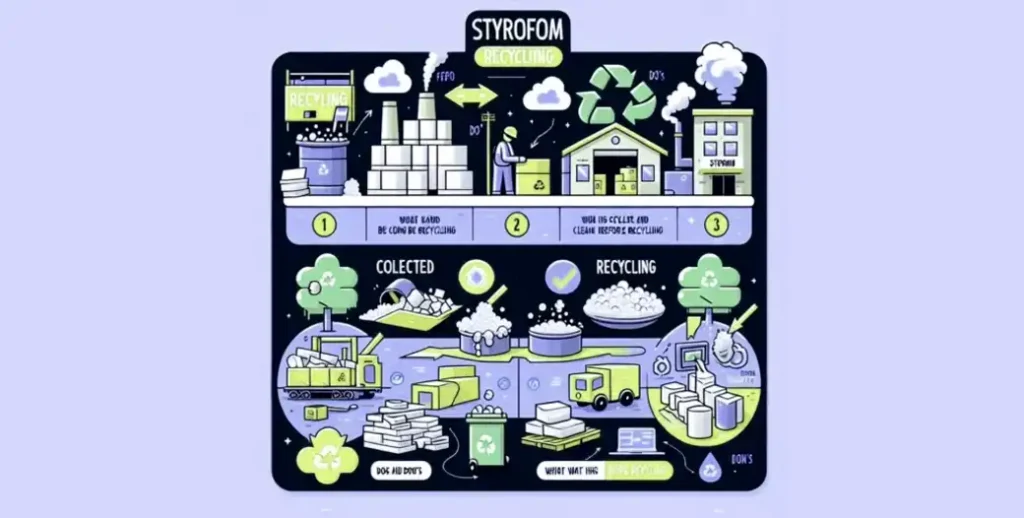Polystyrene foam, commonly known as Styrofoam, is a ubiquitous material in our daily lives. From coffee cups to packaging peanuts, its lightweight and insulating properties make it a popular choice. However, its widespread use raises a critical question: is Styrofoam recyclable? The answer, unfortunately, is more complex than a simple yes or no.
This blog post will delve into the world of Styrofoam recycling, exploring the challenges and possibilities. We’ll examine why many curbside programs don’t accept it, what happens to the Styrofoam that does get recycled, and what you can do to reduce your Styrofoam waste and dispose of it responsibly.
What Is Styrofoam?
Styrofoam, technically known as expanded polystyrene (EPS), is a lightweight plastic material composed of 98% air and 2% polystyrene. It’s commonly used in packaging, insulation, and food containers due to its excellent thermal insulation properties.
Composition of Styrofoam
Styrofoam is a brand name for extruded polystyrene (XPS) foam, but the term is commonly used to describe expanded polystyrene (EPS) foam, which is the material found in many disposable cups and packaging. At its core, the composition of both materials is similar, with a few key differences in their manufacturing process. The main components are:
- Additives: Depending on the intended use, various additives might be included, such as flame retardants or colorants.
- Polystyrene: This is the primary ingredient, a synthetic plastic polymer derived from petroleum. It starts as solid beads or granules.
- Air: A surprising fact is that Styrofoam is about 98% air. This high air content is what makes the material so lightweight and gives it its excellent insulating properties.
- Blowing Agent: A gas, such as pentane, is used to expand the polystyrene beads. When heated, this agent causes the beads to soften, expand, and fuse together, creating the foamed structure.
Is Styrofoam Recyclable?

Yes, Styrofoam is recyclable, but the process presents several challenges due to its unique properties and economic factors. While some recycling facilities accept Styrofoam, many are not equipped to handle it efficiently.
Polystyrene foam, widely known as Styrofoam, is a challenging material to recycle, leading to confusion for many consumers. While it is technically recyclable, it’s not a simple process and is not accepted in most curbside programs. This is primarily due to its composition and physical properties.
- Specialized Equipment: Recycling Styrofoam requires specific machinery to densify it before it can be reprocessed.
- 98% Air: Styrofoam is extremely lightweight and bulky, making it inefficient and expensive to transport to recycling facilities.
- Contamination: It’s often used for food and beverage containers, which makes it difficult to clean and can contaminate other recyclables.
Is Styrofoam Recyclable or Garbage
Styrofoam garbage or recycling?
Styrofoam can be either recyclable or treated as garbage, depending on local recycling capabilities and policies. In areas where recycling facilities accept Styrofoam, it can be recycled.
However, in regions without proper recycling infrastructure or where Styrofoam recycling is not economically viable, it may be disposed of as garbage. Efforts are underway to promote Styrofoam recycling and develop innovative solutions to manage Styrofoam waste more sustainably.
Why is Styrofoam Non Recyclable

Styrofoam, technically known as expanded polystyrene (EPS), presents challenges for recycling due to several factors:
- Lack of Infrastructure: Many recycling facilities are not equipped to handle Styrofoam due to its lightweight and bulky nature. This limits recycling options and often leads to Styrofoam being disposed of in landfills.
- Contamination Issues: Styrofoam is difficult to clean and often contaminated with food residue, making it challenging to recycle effectively. Contamination reduces the quality of recycled material and can lead to rejection by recycling facilities.
- Economic Viability: Recycling Styrofoam is often not economically viable due to low demand for recycled material and high transportation costs. This economic factor discourages investment in Styrofoam recycling infrastructure.
- Limited Market for Recycled Styrofoam: Even if Styrofoam is recycled, there may be a limited market for the recycled material, further reducing the economic incentive for recycling.
These factors contribute to the classification of Styrofoam as non-recyclable in many areas, highlighting the need for innovative solutions to address Styrofoam waste effectively.
Can You Recycle Styrofoam
While technically recyclable, expanded polystyrene foam, commonly known as Styrofoam, is not accepted in most municipal curbside recycling programs. The main reason for this is that Styrofoam is about 98% air. Its lightweight and bulky nature makes it inefficient and costly to transport to recycling facilities, as it takes up a lot of space in trucks and sorting equipment.
Styrofoam is often used for food and beverage containers, which can lead to contamination with food residue, grease, and other substances, making it difficult and expensive to process and potentially ruining entire batches of other recyclable materials.
For Styrofoam to be recycled, it typically needs to be taken to specialized drop-off locations or facilities that have the proper equipment to process it. At these facilities, the foam is densified, which involves shredding and then melting or compressing it into a solid, compact block or ingot.
This process significantly reduces its volume, making it much more economical to store and transport. The densified material can then be shipped to manufacturers who will use it to create new products, such as picture frames, insulation, or even new polystyrene pellets.
What Dissolves Styrofoam?

Styrofoam, also known as expanded polystyrene (EPS), is resistant to many common solvents due to its non-polar nature and closed-cell structure. However, there are certain substances that can dissolve or degrade Styrofoam:
Acetone:
Acetone is a powerful solvent that can dissolve Styrofoam on contact. It breaks down the polystyrene molecules, causing the foam to disintegrate into a sticky residue. However, it’s important to handle acetone with caution due to its flammability and toxicity.
Hydrocarbons:
Certain hydrocarbon-based solvents, such as gasoline, mineral spirits, and paint thinner, can dissolve Styrofoam to some extent. These solvents penetrate the foam’s structure and weaken its bonds, causing it to break apart or soften.
D-limonene:
D-limonene is a natural solvent derived from citrus fruits that has been found to dissolve Styrofoam effectively. It breaks down the foam’s structure without causing harm to the environment.
Other Chemicals:
Some industrial chemicals, such as benzene and toluene, are capable of dissolving Styrofoam. However, these substances are highly toxic and pose serious health risks, so they should be handled with extreme caution and only used in controlled environments by trained professionals.
While these substances can dissolve Styrofoam, it’s important to note that they may also release harmful fumes and pose environmental hazards. Therefore, proper safety precautions should be taken when handling and disposing of Styrofoam and any substances used to dissolve it. Additionally, efforts should be made to minimize the use of Styrofoam and explore alternative materials that are more environmentally friendly.
How to Recycle Styrofoam?
Recycling Styrofoam is possible, but it requires a different approach than traditional curbside recycling. Here are the steps to ensure your Styrofoam is recycled properly and doesn’t end up in a landfill.
Step 1: Find a Local Recycling Center
The first step is to locate a specialized recycling center that accepts Styrofoam. Many municipal recycling programs do not, so you’ll need to use online search tools from organizations like Earth911 or the EPS Industry Alliance. These resources will help you find a drop-off location near you.
Once you have identified a suitable facility, be sure to check their specific requirements. Some centers may only accept certain types of Styrofoam, like clean food packaging or block foam, and may have specific hours for drop-offs. Always call ahead to confirm their policies before you go.
Step 2: Prepare the Styrofoam for Recycling
Before you drop off your Styrofoam, you must prepare it correctly. Remove any tape, labels, or other non-Styrofoam materials from the foam. Make sure the foam is clean, dry, and free of any food residue, as this can contaminate the entire batch and make it unrecyclable.
For block foam, you may need to break it down into smaller, manageable pieces to fit into the recycling center’s collection bins. If you have packaging peanuts, they should be placed in a separate bag. Proper preparation is essential for the recycling process to be successful.
Step 3: Check for Mail-Back Programs
If you are unable to find a local drop-off location, a mail-back program may be an option for you. Several companies and organizations offer these services, allowing you to ship your clean Styrofoam to them for recycling. This is a great alternative for those in rural areas or places without local facilities.
You will need to pack your Styrofoam securely in a box and pay for shipping. Always check the program’s guidelines on what they accept and how to package it. Some programs may offer a discounted rate for shipping or provide pre-paid labels, so it is worth checking.
Where to Take Styrofoam for Recycling
To recycle Styrofoam, you can check with your local recycling facility or waste management department to see if they accept it.
Some recycling centers offer drop-off locations specifically for Styrofoam, while others may host special collection events for Styrofoam recycling.
Additionally, certain retail stores or packaging companies may participate in Styrofoam recycling programs. It’s essential to inquire about the specific guidelines and requirements for Styrofoam recycling in your area to ensure proper disposal and minimize environmental impact.
Does Styrofoam Go in Garbage or Recycling?
Due to its low density and high cost of transportation and processing, Styrofoam is generally not accepted in curbside recycling programs. When a Styrofoam container is placed in a recycling bin, it often ends up contaminating the entire batch of recyclables, which can lead to the entire load being sent to a landfill.
For this reason, in most cases, if you can’t find a specialized recycling center, Styrofoam should be placed in the regular garbage.
- Specialized Processing: Recycling Styrofoam requires specific, expensive densifying equipment that most municipal facilities don’t have.
- Low Value: Styrofoam is mostly air, making it economically unfeasible for many recycling facilities to process.
- Contamination Risk: Food residue on Styrofoam containers can contaminate other materials, making them unrecyclable.
Challenges in Styrofoam Recycling

Challenges in Styrofoam recycling stem from several factors:
Lack of Infrastructure: Many recycling facilities lack the necessary equipment to efficiently handle Styrofoam due to its lightweight and bulky nature. This deficiency limits the recycling options available and often results in Styrofoam being disposed of in landfills.
Contamination Issues: Styrofoam is challenging to clean thoroughly and is often contaminated with food residue or other substances. This contamination reduces the quality of the recycled material and can lead to rejection by recycling facilities.
Economic Viability: Recycling Styrofoam is often not economically feasible due to low demand for recycled material and high transportation costs. The lack of economic incentive discourages investment in Styrofoam recycling infrastructure.
Limited Market for Recycled Styrofoam: Even if Styrofoam is successfully recycled, there may be a limited market for the recycled material. This limited demand further diminishes the economic viability of Styrofoam recycling efforts.
Addressing these challenges requires innovative solutions, increased awareness, and investment in recycling infrastructure to improve Styrofoam recycling rates and reduce its environmental impact.
Innovative Recycling Solutions:
Despite challenges, innovative solutions are emerging to address the issue of Styrofoam waste and promote recycling.
Mechanical Recycling:
Mechanical recycling involves breaking down Styrofoam into smaller pellets, which can then be used to manufacture new products such as picture frames, crown molding, and decking materials.
Chemical Recycling:
Chemical recycling processes break down Styrofoam into its chemical components, allowing for the production of new polymers or fuels. These innovative techniques offer potential solutions to Styrofoam waste management.
Foam Densifiers:
Foam densifiers compress Styrofoam into dense blocks, reducing its volume for easier transportation and storage. These machines play a crucial role in facilitating Styrofoam recycling efforts.
Sustainable Alternatives to Styrofoam:
In response to environmental concerns, various sustainable alternatives to Styrofoam are gaining popularity.
Biodegradable Packaging Materials:
Biodegradable packaging materials, such as molded pulp and cornstarch-based packaging, offer eco-friendly alternatives to Styrofoam. These materials decompose naturally, reducing environmental impact.
Reusable Containers:
Switching to reusable containers and packaging reduces reliance on single-use Styrofoam products, minimizing waste and promoting sustainability.
Eco-Friendly Insulation:
Alternative insulation materials, such as recycled denim and cellulose insulation, provide energy-efficient and environmentally friendly alternatives to Styrofoam insulation.
Can all types of Styrofoam be recycled?
Not all types of Styrofoam are recyclable. Expanded polystyrene (EPS) is commonly accepted for recycling, while other types may not be.
How to Recycle Styrofoam Blocks?
Styrofoam blocks can typically be recycled at specialized recycling facilities or drop-off locations. It’s essential to ensure that the blocks are clean and free from any contaminants before recycling. Check with your local recycling center for specific instructions on how to recycle Styrofoam blocks in your area.
How to Recycle Styrofoam Boxes?
Styrofoam boxes, commonly used for packaging and shipping, can often be recycled at designated drop-off locations or recycling centers. Before recycling, make sure to remove any labels or tape from the boxes and clean them thoroughly to prevent contamination
How to Recycle Styrofoam Containers?
Styrofoam containers, such as those used for takeout food or food packaging, can be recycled at some recycling facilities. Ensure that the containers are clean and free from any food residue before recycling. Check with your local recycling center for specific instructions on recycling Styrofoam containers.
How to Recycle Styrofoam Coolers?
Styrofoam coolers, often used for transporting perishable items, can sometimes be recycled at specialized recycling facilities. Before recycling, remove any non-recyclable components such as metal hinges or plastic handles. Check with your local recycling center for guidance on recycling Styrofoam coolers.
How to Recycle Styrofoam Cups?
Styrofoam cups can be recycled at certain recycling centers or drop-off locations. Before recycling, ensure that the cups are clean and free from any liquid or food residue. Remove any lids or straws before recycling. Check with your local recycling center for specific instructions on recycling Styrofoam cups.
How to Recycle Styrofoam Egg Cartons?
Styrofoam egg cartons can often be recycled at certain recycling centers or drop-off locations. Before recycling, ensure that the egg cartons are clean and free from any egg residue. Check with your local recycling center for specific instructions on recycling Styrofoam egg cartons.
How to Recycle Styrofoam Food Containers?
Styrofoam food containers, such as those used for takeout food or food packaging, can be recycled at some recycling facilities. Ensure that the containers are clean and free from any food residue before recycling. Check with your local recycling center for specific instructions on recycling Styrofoam food containers.
Conclusion
In conclusion, the recyclability of Styrofoam is a nuanced issue. While not all Styrofoam is created equal, and not all municipalities have the infrastructure to process it, progress is being made. By seeking out dedicated drop-off locations and supporting companies that utilize recycled polystyrene, we can all contribute to a more sustainable future.
The journey toward a circular economy for Styrofoam requires collective action. As consumers, we can prioritize products with eco-friendly packaging and reuse Styrofoam whenever possible. As businesses, we can explore innovative recycling technologies and make conscious choices to reduce our reliance on virgin materials.
If you’re a business looking to make a change, consider sourcing your wholesale Styrofoam from Epsole. Our commitment to sustainability means we offer high-quality products while actively working to minimize our environmental impact. By partnering with us, you can ensure your business is part of the solution, not the problem.
